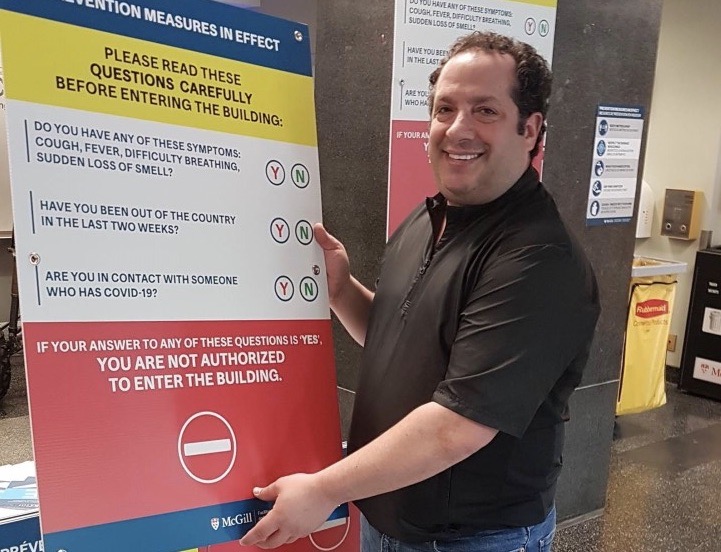
It is late May and the progressive ramping up of research activities is underway at McGill. George Lazaris, Director of Buildings and Grounds, is making a final visit to the buildings that are scheduled to open next. His team has been busy installing the signage that will direct the building users to the designated entrances and exits, provide instructions on how to use the elevators, and remind them of hygiene and physical distancing directives.
“This second group of buildings was demanding,” Lazaris says of the seven research-intensive buildings that were part of Phase 2 of the gradual research ramp-up. Especially demanding since Lazaris’s unit is also responsible for cleaning and disinfecting the buildings.
“We clean and disinfect all common areas. In the case of high-touch surfaces, it’s done every two hours,” Lazaris explains. “Users are responsible for cleaning their work surfaces and equipment.”
Buildings and Grounds also receives all orders of personal protective equipment (PPE), such as masks, gloves and disinfectants, and delivers them to the labs.
Prepping buildings to reopen
Meanwhile, the Building Operations team has also been busy getting the buildings ready for the reopening of labs. “We are purging the indoor air out of the buildings and reprogramming each of the HVAC systems to increase outdoor air intake, up to 100 per cent fresh air, where possible,” says Dominic Gagnon, HVAC Manager.
Although viruses such as SARS-CoV-2 are not known to spread through HVAC systems, McGill is taking the additional precaution of maximizing outdoor air intake, in accordance with recommendations from the industry and public health experts. Moreover, all drinking water pipes are flushed before the reopening of a building.
These operations all fall under Facilities Management and Ancillary Services (FMAS), arguably the McGill unit that has had the most staff working on McGill campuses since mid-March. “Over 250 employees from FMAS have been working regularly on campus, many of them every day, especially since the start of the ramp-up of research and construction activities,” says Denis Mondou, newly-appointed Associate Vice-Principal, FMAS. “Shifts are staggered so we can meet physical distancing requirements.”
Health and safety first
Efficient cleaning protocols, proper signage and adequate provisioning of PPE are some of the factors going into the Emergency Operations Centre (EOC)’s assessment of whether the University can safely proceed with the next phase of the phase-in. “The health and safety of our community is the top guiding principle right now. We will only authorize access to additional buildings if we are confident that we can provide a healthy and safe environment,” says Pierre Barbarie, Director of Campus Public Safety (CPS) and EOC Director for the COVID-19 response.
Run by the Emergency Management and Preparedness staff at CPS, the EOC brings together representatives from many areas of the University, from academic, administrative and operational units to legal and communications advisors. The EOC’s mandate is to oversee the continuity of activities in accordance with government directives and public health and safety guidelines.
One of the key units advising the EOC and its subcommittees since the appearance of COVID-19 has been Environmental Health and Safety (EHS).
“We review all the frameworks and guidelines that are developed for the activities that resume or as part of the Fall semester planning, as well as the protocols to follow if we learn of a positive diagnosis on campus,” says Joseph Vincelli, Operations Manager, EHS. “This is in addition to the building walkthroughs on the ground.”
The small EHS staff has been visiting the labs as they reopen to monitor compliance with safety directives. Their assessment is critical in helping the EOC decide to give the green light to move to the next phase of the ramp-up.
Security Services are also brought in before buildings can welcome back the staff and students who have been authorized to return to campus. Agents tour the buildings beforehand to designate entrances and exits to be used. Once users are back, they monitor who is entering buildings, reminding them to wash or disinfect their hands and to respect physical distancing guidelines.
Furthermore, they have to make sure that the empty buildings also remain safe. “We patrol every building every 24 hours. It’s all the more important to do that right now because if there’s a safety hazard, there is no one there to report it,” says Christopher Carson, Associate Director, Security Services.
